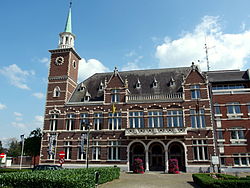Eisden
| Maasmechelen | |||
|---|---|---|---|
| Municipality | |||

Maasmechelen town hall
|
|||
|
|||
| Location in Belgium | |||
| Coordinates: 50°58′N 05°42′E / 50.967°N 5.700°ECoordinates: 50°58′N 05°42′E / 50.967°N 5.700°E | |||
| Country | Belgium | ||
| Community | Flemish Community | ||
| Region | Flemish Region | ||
| Province | Limburg | ||
| Arrondissement | Tongeren | ||
| Government | |||
| • Mayor | Raf Terwingen (Cd&V) | ||
| • Governing party/ies | VLD, N-VA | ||
| Area | |||
| • Total | 76.28 km2 (29.45 sq mi) | ||
| Population (1 January 2016) | |||
| • Total | 37,696 | ||
| • Density | 490/km2 (1,300/sq mi) | ||
| Postal codes | 3630-3631 | ||
| Area codes | 089 | ||
| Website | www.maasmechelen.be | ||
Maasmechelen is a municipality located on the Meuse river in the Belgian province of Limburg.
It comprises the former municipalities of Mechelen-aan-de-Maas, Vucht, Leut, Meeswijk, Uikhoven, Eisden, Opgrimbie, Boorsem, and Kotem.
As a result of both Maasmechelen’s location near the border and its coalmining history quite a few of its current inhabitants are from Dutch, German, Eastern European (e.g., Polish) or Mediterranean (mainly Italian) origin.
The plateau of Campine was built up during the ice age with deposits of sand and other material that the Meuse river had eroded in the upstream Ardennes region. The higher elevation and the proximity of fertile river clay made this location an attractive one for the prehistoric tribes who established themselves here in the 2nd millennium BC and for the Celtic peoples who moved in the area in the 1st millennium BC.
In Roman times, this region was at the border between the provinces of Gallia Belgica and Germania Inferior. The main Roman road crossed the river near Maastricht, to the south. Settlements were built where Maasmechelen lies today to service the garrison that was maintained to protect the bridge in Maastricht.
The few centuries that followed the fall of the Roman Empire were marked by a sharp decline in travel and trade. The Franks were now the new masters of the land. International commercial activities resumed on the river around the 7th century. This was also a time when the river progressively moved eastward. The Roman colonies that were originally built on the right bank of the river now found themselves on the left bank. The abundance of streams and wetlands favoured stockbreeding over agriculture. The feudal system and the practice of paying civil servants with land resulted in endless territory subdivisions. Some parcels, including Mechelen-aan-de-Maas and parts of Opgrimbie, were given to the abbey of Saint Servatius in Maastricht. Other parcels came into the hands of local lords, who pledged allegiance to the Holy Roman Emperor. Yet other parts of the territory came into the possession of local religious communities. Churches and cloisters were built and enlarged to accommodate a growing population.
...
Wikipedia




